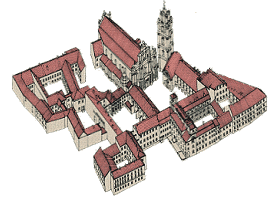|
|
|
|

|
Library Courtyard
The Library Courtyard is one of the university's oldest;
it was formed at the end of the 16th century, together with the Observatory
and Great Courtyards.
Deep in the interior of the courtyard rises the monumental, three-storey high University
Library building facade, one of the oldest on the campus. On the right is the astronomy
observatory building, the very oldest part of the university complex. In 1978, the Gothic
two-storey high facade of this building was opened onto Universiteto St. The building's
principal embellishments - representations, between the rococo fourth-storey windows, of
stucco pilasters and fresco paintings of mathematical and astronomic instruments - give
the edifice an ornate and stately air. The main entrance to the Vilnius University is
located in the east corner of the building; on the left are the library's commemorative
doors, dedicated to the first Lithuanian book.
In 1996 in view of the approaching 450th anniversary of Catechismus by Martynas Mažvydas a tender was
launched with the aim of perpetuating the place in which the first Lithuanian book is kept. The tender
was awarded to a sculptor Jonas Meškelevičius who proposed to create a memorial entrance door to the
Vilnius University Library by depicting major events of the Lithuanian culture and some of its eminent
figures. Upon the Rector's decree a Commission was set up including prof. Benediktas Juodka, prof. Domas
Kaunas, prof. Algirdas Šidlauskas, prof. Vygintas Bronius Pšibilskis, prof. Eugenija Ulčinaitė, Director
of the VU Library Birutė Butkevičienė and Deputy Director Irena Krivienė. The members of the Commission
had to decide what events had to be represented on the Door.
Based on the Commission's proposal the following bronze images have been cast at the top of the door:
Kristupas Radvila Našlaitėlis, the founder of a printing house in Vilnius in 1575, (later - Vilnius
Academy printing house (1585 m.) who in 1613 published the first original map of the Grand Duchy of
Lithuania Magni Ducatus Lithuaniae caeterarumque …; Vilnius bishop Valerijonas Protasevičius, who in
1570 founded the Vilnius Jesuit College and its Library; the Pope Gregory XIII, who on October 29,
1579 confirmed by the bull the establishment of the Vilnius University; Cardinal Jurgis Radvila,
Maecenas of the University, who addressed the Pope asking him to grant the rights of the Academy to
the Vilnius College; Sigismundus Augustus, the Grand Duke of Lithuania and King of Poland, who donated
his personal collection of books (4 - 5 thousand volumes) to the newly established Library ; the Grand
Duke of Lithuania and King of Poland Stephan Batory, who on April 1, 1579 issued a charter allowing for
the reorganisation of the Vilnius Jesuit College into the Academy and the University. Right in the middle
one can see the University's coat of arms, below it the inscription which reads: To the first Lithuanian
book 1547-1997.
On the upper part of the bronze door the first page of M. Mažvydas' Catechismus is depicted; next to it -
Mikalojus Daukša's Postilė, slightly below views of the two universities - Konigsberg and Vilnius - can be
seen; also depicted are: Konstantinas Sirvydas - the first Lithuanian linguist, Kristijonas Donelaitis - the
progenitor of the Lithuanian literature, Simonas Daukantas - the father of the Lithuanian history, Motiejus
Valančius - a Lithuanian enlightener; Jonas Basanavičius, Jurgis Bielinis, Vincas Kudirka, Vaclovas
Biržiška, Mykolas Biržiška, Vincas Mykolaitis-Putinas - all of the prominent figures of the Lithuanian
history of culture and men of letters. The door handles depict brownies said to bring prosperity to
people and their homes.
At the bottom of the Door there are words from the book by the poet Justinas Marcinkevičius "Tree of
Knowledge"
To those men, who fostered the Lithuanian Word
To those books, that rocked our cradle
On the left of the courtyard is a three-storey building
with a memorial plaque to the Ukrainian poet T.Ševčenka. Located here is the history
faculty. The courtyard is connected, via narrow arched passage-ways, to the M.Daukša
and M.K.Sarbievius Courtyards. On the opposite side of the street are the buildings
of the Lithuanian Presidency.








